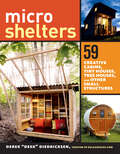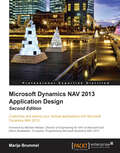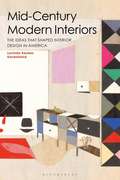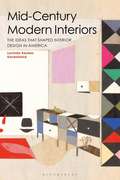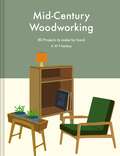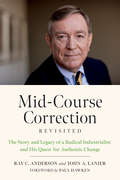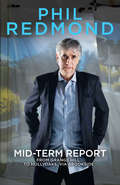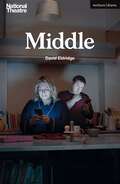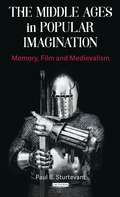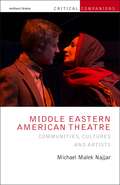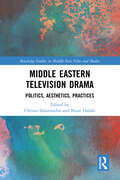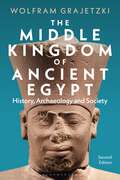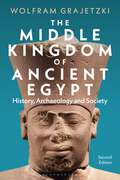- Table View
- List View
Microhistories of Memory: Remediating the Holocaust by Bullets in Postwar West Germany (Worlds of Memory #13)
by Magdalena Saryusz-WolskaThe West German novel, radio play, and television series Through the Night (Am grünen Strand der Spree, 1955–1960), which depicts the mass shootings of Jews in the occupied Soviet Union during World War II, has gradually regained popularity in recent years. Originally circulated in postwar West Germany, the Holocaust representations embedded in this multi-medium work have shaped cultural memories up until today. Using numerous archival sources, Microhistories of Memory presents three comprehensive case studies to explore production, reception, and circulation of cultural memories, demonstrating the power of informal communication and providing behind-the-scenes insight into postwar memory culture in West Germany.
Micromuseology: An Analysis of Small Independent Museums
by Fiona CandlinHow would our understanding of museums change if we used the Vintage Wireless Museum or the Museum of Witchcraft as examples – rather than the British Museum or the Louvre? Although there are thousands of small, independent, single-subject museums in the UK, Europe and North America, the field of museum studies remains focused almost exclusively on major institutions.In this ground-breaking new book, Fiona Candlin reveals how micromuseums challenge preconceived ideas about what museums are and how they operate. Based on extensive fieldwork and analysis of more than fifty micromuseums, she shows how they offer dramatically different models of curation, interpretation and visitor experience, and how their analysis generates new perspectives on subjects such as display, objects, collections, architecture, and the public sphere. The first-ever book dedicated to the subject, Micromuseology provides a platform for radically rethinking key debates within museum studies. Destined to transform the field, it is essential reading for students and researchers in museum studies, anthropology, material culture studies, and visual culture.
Micromuseology: An Analysis of Small Independent Museums
by Fiona CandlinHow would our understanding of museums change if we used the Vintage Wireless Museum or the Museum of Witchcraft as examples – rather than the British Museum or the Louvre? Although there are thousands of small, independent, single-subject museums in the UK, Europe and North America, the field of museum studies remains focused almost exclusively on major institutions.In this ground-breaking new book, Fiona Candlin reveals how micromuseums challenge preconceived ideas about what museums are and how they operate. Based on extensive fieldwork and analysis of more than fifty micromuseums, she shows how they offer dramatically different models of curation, interpretation and visitor experience, and how their analysis generates new perspectives on subjects such as display, objects, collections, architecture, and the public sphere. The first-ever book dedicated to the subject, Micromuseology provides a platform for radically rethinking key debates within museum studies. Destined to transform the field, it is essential reading for students and researchers in museum studies, anthropology, material culture studies, and visual culture.
Microphone Fiends: Youth Music and Youth Culture
by Tricia Rose Andrew RossMicrophone Fiends, a collection of original essays and interviews, brings together some of the best known scholars, critics, journalists and performers to focus on the contemporary scene. It includes theoretical discussions of musical history along with social commentaries about genres like disco, metal and rap music, and case histories of specific movements like the Riot Grrls, funk clubbing in Rio de Janeiro, and the British rave scene.
Microphone Fiends: Youth Music and Youth Culture
by Andrew Ross Tricia RoseMicrophone Fiends, a collection of original essays and interviews, brings together some of the best known scholars, critics, journalists and performers to focus on the contemporary scene. It includes theoretical discussions of musical history along with social commentaries about genres like disco, metal and rap music, and case histories of specific movements like the Riot Grrls, funk clubbing in Rio de Janeiro, and the British rave scene.
Microshelters: 59 Creative Cabins, Tiny Houses, Tree Houses, and Other Small Structures
by Derek “Deek” DiedricksenDiscover how "big" tiny can be! With stunning photographs, fascinating information, and plans to build your own, Microshelters proves that small structures are not only useful, but stylish as well.
Microsoft Dynamics NAV 2013 Application Design
by Mark BrummelIf you are a NAV consultant and developer or a designer of business applications, you will benefit most from this book. This book assumes that you have a basic understanding of business management systems and application development with working knowledge of Microsoft Dynamics NAV.
Mid-Century Modern Interiors: The Ideas that Shaped Interior Design in America
by Lucinda Kaukas HavenhandMid-Century Modern Interiors explores the history of interior design during arguably its most iconic and influential period. The 1930s to the 1960s in the United States was a key moment for interior design. It not only saw the emergence of some of interior design's most globally-important designers, it also saw the field of interior design emerge at last as a profession in its own right. Through a series of detailed case studies this book introduces the key practitioners of the period – world-renowned designers including Ray and Charles Eames, Richard Neutra, and George Nelson – and examines how they developed new approaches by applying systematic and rational principles to the creation of interior spaces. It takes us into the mind of the designer to show how they each used interior design to express their varied theoretical interests, and reveals how the principles they developed have become embodied in the way interior design is practiced today. This focus on unearthing the underlying ideas and concepts behind their designs rather than on the finished results creates a richer, more conceptual understanding of this pivotal period in modernist design history.With an extended introduction setting the case studies within the broader context of twentieth-century design and architectural history, this book provides both an introduction and an in-depth analysis for students and scholars of interior design, architecture and design history.
Mid-Century Modern Interiors: The Ideas that Shaped Interior Design in America
by Lucinda Kaukas HavenhandMid-Century Modern Interiors explores the history of interior design during arguably its most iconic and influential period. The 1930s to the 1960s in the United States was a key moment for interior design. It not only saw the emergence of some of interior design's most globally-important designers, it also saw the field of interior design emerge at last as a profession in its own right. Through a series of detailed case studies this book introduces the key practitioners of the period – world-renowned designers including Ray and Charles Eames, Richard Neutra, and George Nelson – and examines how they developed new approaches by applying systematic and rational principles to the creation of interior spaces. It takes us into the mind of the designer to show how they each used interior design to express their varied theoretical interests, and reveals how the principles they developed have become embodied in the way interior design is practiced today. This focus on unearthing the underlying ideas and concepts behind their designs rather than on the finished results creates a richer, more conceptual understanding of this pivotal period in modernist design history.With an extended introduction setting the case studies within the broader context of twentieth-century design and architectural history, this book provides both an introduction and an in-depth analysis for students and scholars of interior design, architecture and design history.
Mid-Century Modernism and the American Body: Race, Gender, and the Politics of Power in Design
by Kristina WilsonThe first investigation of how race and gender shaped the presentation and marketing of Modernist decor in postwar AmericaIn the world of interior design, mid-century Modernism has left an indelible mark still seen and felt today in countless open-concept floor plans and spare, geometric furnishings. Yet despite our continued fascination, we rarely consider how this iconic design sensibility was marketed to the diverse audiences of its era. Examining advice manuals, advertisements in Life and Ebony, furniture, art, and more, Mid-Century Modernism and the American Body offers a powerful new look at how codes of race, gender, and identity influenced—and were influenced by—Modern design and shaped its presentation to consumers.Taking us to the booming suburban landscape of postwar America, Kristina Wilson demonstrates that the ideals defined by popular Modernist furnishings were far from neutral or race-blind. Advertisers offered this aesthetic to White audiences as a solution for keeping dirt and outsiders at bay, an approach that reinforced middle-class White privilege. By contrast, media arenas such as Ebony magazine presented African American readers with an image of Modernism as a style of comfort, security, and social confidence. Wilson shows how etiquette and home decorating manuals served to control women by associating them with the domestic sphere, and she considers how furniture by George Nelson and Charles and Ray Eames, as well as smaller-scale decorative accessories, empowered some users, even while constraining others.A striking counter-narrative to conventional histories of design, Mid-Century Modernism and the American Body unveils fresh perspectives on one of the most distinctive movements in American visual culture.
Mid-Century Modernism and the American Body: Race, Gender, and the Politics of Power in Design
by Kristina WilsonThe first investigation of how race and gender shaped the presentation and marketing of Modernist decor in postwar AmericaIn the world of interior design, mid-century Modernism has left an indelible mark still seen and felt today in countless open-concept floor plans and spare, geometric furnishings. Yet despite our continued fascination, we rarely consider how this iconic design sensibility was marketed to the diverse audiences of its era. Examining advice manuals, advertisements in Life and Ebony, furniture, art, and more, Mid-Century Modernism and the American Body offers a powerful new look at how codes of race, gender, and identity influenced—and were influenced by—Modern design and shaped its presentation to consumers.Taking us to the booming suburban landscape of postwar America, Kristina Wilson demonstrates that the ideals defined by popular Modernist furnishings were far from neutral or race-blind. Advertisers offered this aesthetic to White audiences as a solution for keeping dirt and outsiders at bay, an approach that reinforced middle-class White privilege. By contrast, media arenas such as Ebony magazine presented African American readers with an image of Modernism as a style of comfort, security, and social confidence. Wilson shows how etiquette and home decorating manuals served to control women by associating them with the domestic sphere, and she considers how furniture by George Nelson and Charles and Ray Eames, as well as smaller-scale decorative accessories, empowered some users, even while constraining others.A striking counter-narrative to conventional histories of design, Mid-Century Modernism and the American Body unveils fresh perspectives on one of the most distinctive movements in American visual culture.
Mid-Century Modernism in Turkey: Architecture Across Cultures in the 1950s and 1960s (Routledge Research in Architecture)
by Meltem Ö GürelMid-Century Modernism in Turkey studies the unfolding of modern architecture in Turkey during the 1950s and 1960s. The book brings together scholars who have carried out extensive research on post-WWII modernism in a global context. The authors situate Turkish architectural case studies within an international framework during this period, providing a close reading of how architectural culture responded to ubiquitous post-war ideas and ideals, and how it became intertwined with politics of modernization and urbanization. This book contributes to contemporary scholarship to reconsider post-war architecture, beyond canonical explanations.
Mid-Century Modernism in Turkey: Architecture Across Cultures in the 1950s and 1960s (Routledge Research in Architecture)
by Meltem Ö. GürelMid-Century Modernism in Turkey studies the unfolding of modern architecture in Turkey during the 1950s and 1960s. The book brings together scholars who have carried out extensive research on post-WWII modernism in a global context. The authors situate Turkish architectural case studies within an international framework during this period, providing a close reading of how architectural culture responded to ubiquitous post-war ideas and ideals, and how it became intertwined with politics of modernization and urbanization. This book contributes to contemporary scholarship to reconsider post-war architecture, beyond canonical explanations.
Mid-Course Correction Revisited: The Story and Legacy of a Radical Industrialist and his Quest for Authentic Change
by Ray Anderson John A. LanierThe original Mid-Course Correction, published 20 years ago, became a classic in the sustainability field. It put forth a new vision for what its author, Ray C. Anderson, called the “prototypical company of the 21st century”—a restorative company that does no harm to society or the environment. In it Anderson recounts his eureka moment as founder and leader of Interface, Inc., one of the world’s largest carpet and flooring companies, and one that was doing business in all the usual ways. Bit by bit, he began learning how much environmental destruction companies like his had caused, prompting him to make a radical change. Mid-Course Correction not only outlined what eco-centered leadership looks like, it also mapped out a specific set of goals for Anderson’s company to eliminate its environmental footprint. Those goals remain visionary even today, and this second edition delves into how Interface worked toward making them a reality, birthing one of the most innovative and successful corporate sustainability efforts in the world. The new edition also explores why we need to create not only prototypical companies, but also the prototypical economy of the twenty-first century. As our global economy shifts toward sustainability, challenges like building the circular economy and reversing global warming present tremendous opportunities for business and industry. Mid-Course Correction Revisted contains a new foreword by Paul Hawken, several new chapters by Ray C. Anderson Foundation executive director John A. Lanier, and interviews with Janine Benyus, Joel Makower, Andrew Winston, Ellen MacArthur and other leaders in green enterprise, the circular economy, and biomimicry. A wide range of business readers—from sustainability professionals to green entrepreneurs to CEOs—will find both wise advice and concrete examples in this new look at a master in corporate and environmental leadership, and the legacy he left.
Mid-Term Report: From Grange Hill To Hollyoaks, Via Brookside
by Phil RedmondA masterclass in media studies from the creator of Grange Hill, Brookside and Hollyoaks. Described in Parliament as 'excellent' by Ed Vaizey, The Parliamentary Under-Secretary of State for Culture, Media and Sport GRANGE HILLSwimming pool disasters. Drugs, and just say ‘no’. Flying sausages. School like you’d never seen it before.BROOKSIDELesbian kisses. Bodies under patios. Exploding shops. Suburban life like you’d never seen it before.HOLLYOAKSBad boys on bikes. Loveable geeks. Leggy blondes. Students like you’d never seen them before.PHIL REDMONDThree classic TV programmes. One TV genius. This is the behind-the-scenes story of how a working-class lad from the Liverpool suburbs went from living on a housing estate to buying one, and from comprehensive school dinners to lunch with the Queen. Along the way he learned a lot of lessons, broke all the rules, and changed television for ever.
Middle (Modern Plays)
by David EldridgeWhy do people ever see things through?Why do they ever stay?It's so hard.Every relationship reaches a crossroad some time.As dawn breaks, Maggie is heating some milk and Gary wonders what she's doing out of bed. Maybe it's time for an honest conversation – but how much honesty can this marriage take?Following his five-star play Beginning, which played sold-out runs at the National Theatre and in the West End, writer David Eldridge brings his raw, touching and funny style to a portrait of a 21st century marriage, the second of three plays to explore love and relationships.
Middle (Modern Plays)
by David EldridgeWhy do people ever see things through?Why do they ever stay?It's so hard.Every relationship reaches a crossroad some time.As dawn breaks, Maggie is heating some milk and Gary wonders what she's doing out of bed. Maybe it's time for an honest conversation – but how much honesty can this marriage take?Following his five-star play Beginning, which played sold-out runs at the National Theatre and in the West End, writer David Eldridge brings his raw, touching and funny style to a portrait of a 21st century marriage, the second of three plays to explore love and relationships.
The Middle Ages in Popular Imagination: Memory, Film and Medievalism (New Directions in Medieval Studies)
by Paul B. SturtevantIt is often assumed that those outside of academia know very little about the Middle Ages. But the truth is not so simple. Non-specialists in fact learn a great deal from the myriad medievalisms – post-medieval imaginings of the medieval world – that pervade our everyday culture. These, like Lord of the Rings or Game of Thrones, offer compelling, if not necessarily accurate, visions of the medieval world. And more, they have an impact on the popular imagination, particularly since there are new medievalisms constantly being developed, synthesised and remade. But what does the public really know? How do the conflicting medievalisms they consume contribute to their knowledge? And why is this important? In this book, the first evidence-based exploration of the wider public's understanding of the Middle Ages, Paul B. Sturtevant adapts sociological methods to answer these important questions. Based on extensive focus groups, the book details the ways – both formal and informal – that people learn about the medieval past and the many other ways that this informs, and even distorts, our present. In the process, Sturtevant also sheds light, in more general terms, onto the ways non-specialists learn about the past, and why understanding this is so important. The Middle Ages in Popular Imagination will be of interest to anyone working on medieval studies, medievalism, memory studies, medieval film studies, informal learning or public history.
Middle Eastern American Theatre: Communities, Cultures and Artists (Critical Companions)
by Michael Malek NajjarMiddle Eastern American Theatre explores the burgeoning Middle Eastern American theatre movement with a focus on Arab American, Jewish American, Armenian American, Iranian American, and Turkish American theatres, playwrights, directors, and actors. By exploring the rich religious and cultural heritage of this diverse group - which includes Arabs, Armenians, Iranians, Jews, and Turks - and religions that include the Baha'i faith, Christianity, Chaldean, Druze, Ishik Alevism, Judaism, Islam, Mandaeism, Samaratin, Shabakism, Yazidi, and Zoroastrianism - the rich and paradoxical nature of the term 'Middle Eastern' is interrogated through the dramas written and performed by those in the Diaspora. Featuring a clear introduction and examination of the context and the various push and pull factors that have contributed to the mass migrations to North America - including the so-called “Great Migration” of 1890-1915, the Armenian Genocide, the European Holocaust, the two world wars, the Israeli/Palestinian conflict, and other social and political conflicts. With chapters devoted to Arab American, Israeli American, Iranian American and Turkish American theatre, Middle Eastern American Theatre traces the history and examines the work of key artists and directors including Heather Raffo, Yussef El Guindi, Jamil Khoury, Mona Mansour, Danny Bryck, Ken Kaissar, Ari Roth, Torange Yeghiazarian, Reza Abdoh, Sedef Ecer, Torange Yeghiazarian, of Golden Thread Productions, and Jamil Khoury, of Silk Road Rising. The volume provides readers with a deeper and more nuanced understanding of millions of Middle Eastern Americans, and how they have contributed to American theatre today.
Middle Eastern American Theatre: Communities, Cultures and Artists (Critical Companions)
by Michael Malek NajjarMiddle Eastern American Theatre explores the burgeoning Middle Eastern American theatre movement with a focus on Arab American, Jewish American, Armenian American, Iranian American, and Turkish American theatres, playwrights, directors, and actors. By exploring the rich religious and cultural heritage of this diverse group - which includes Arabs, Armenians, Iranians, Jews, and Turks - and religions that include the Baha'i faith, Christianity, Chaldean, Druze, Ishik Alevism, Judaism, Islam, Mandaeism, Samaratin, Shabakism, Yazidi, and Zoroastrianism - the rich and paradoxical nature of the term 'Middle Eastern' is interrogated through the dramas written and performed by those in the Diaspora. Featuring a clear introduction and examination of the context and the various push and pull factors that have contributed to the mass migrations to North America - including the so-called “Great Migration” of 1890-1915, the Armenian Genocide, the European Holocaust, the two world wars, the Israeli/Palestinian conflict, and other social and political conflicts. With chapters devoted to Arab American, Israeli American, Iranian American and Turkish American theatre, Middle Eastern American Theatre traces the history and examines the work of key artists and directors including Heather Raffo, Yussef El Guindi, Jamil Khoury, Mona Mansour, Danny Bryck, Ken Kaissar, Ari Roth, Torange Yeghiazarian, Reza Abdoh, Sedef Ecer, Torange Yeghiazarian, of Golden Thread Productions, and Jamil Khoury, of Silk Road Rising. The volume provides readers with a deeper and more nuanced understanding of millions of Middle Eastern Americans, and how they have contributed to American theatre today.
Middle Eastern Television Drama: Politics, Aesthetics, Practices (Routledge Studies in Middle East Film and Media)
by Christa Salamandra Nour HalabiThis monograph explores and investigates key issues facing Middle Eastern societies, including religion and sectarianism, history and collective memory, urban space and socioeconomic difference, policing and securitization, and gender relations. In the Middle East, television drama creators serve as public intellectuals who, with uncanny prescience, tell the world something. As this volume demonstrates, fictional television provides a crucial space for social and political debate in much of the region. Writing from a range disciplines—anthropology, communication, folklore, gender studies, history, and law— contributors include seasoned academics who have dedicated their careers to researching Middle Eastern media and emerging scholars who build on earlier work and introduce fresh perspectives. Together, they provide an invaluable overview of Middle Eastern serial television and their political impact, drawing examples from Afghanistan, Egypt, Iran, Syria, and Turkey. Bringing together a diverse range of academic perspectives, this book will be of key interest to students and scholars in media and communication studies, Middle Eastern Studies, and popular culture studies.
Middle Eastern Television Drama: Politics, Aesthetics, Practices (Routledge Studies in Middle East Film and Media)
This monograph explores and investigates key issues facing Middle Eastern societies, including religion and sectarianism, history and collective memory, urban space and socioeconomic difference, policing and securitization, and gender relations. In the Middle East, television drama creators serve as public intellectuals who, with uncanny prescience, tell the world something. As this volume demonstrates, fictional television provides a crucial space for social and political debate in much of the region. Writing from a range disciplines—anthropology, communication, folklore, gender studies, history, and law— contributors include seasoned academics who have dedicated their careers to researching Middle Eastern media and emerging scholars who build on earlier work and introduce fresh perspectives. Together, they provide an invaluable overview of Middle Eastern serial television and their political impact, drawing examples from Afghanistan, Egypt, Iran, Syria, and Turkey. Bringing together a diverse range of academic perspectives, this book will be of key interest to students and scholars in media and communication studies, Middle Eastern Studies, and popular culture studies.
The Middle Kingdom of Ancient Egypt: History, Archaeology and Society
by Wolfram GrajetzkiFor the ancient Egyptians, the Middle Kingdom (c. 2000-1700 BC) was a classical period of art, history and literature. The Twelfth Dynasty was one of the strongest ever to rule on the banks of the Nile: some of its kings were later worshipped as local gods, and were made famous by classical Greek authors. Yet Egyptologists tend not to look beyond the extraordinary royal sculpture and literary masterpieces of the time. Although the picture is fragmentary, as with any archaeological record, the last two hundred years of exploration and excavation have revealed much of the splendour of the period. This book examines the evidence for the culture, history and society of both central and provincial Egypt at the time, revealing the wealth of the entire country. In this second edition, Wolfram Grajetzki incorporates recent discoveries, discussions and publications which have emerged over the intervening fifteen years, including new excavation reports for the mastabas at Lisht and excavations at Abydos. Too often overshadowed by the better-preserved architecture of other periods, Middle Kingdom Egypt emerges for the reader as a fascinating age in its own right.
The Middle Kingdom of Ancient Egypt: History, Archaeology and Society
by Wolfram GrajetzkiFor the ancient Egyptians, the Middle Kingdom (c. 2000-1700 BC) was a classical period of art, history and literature. The Twelfth Dynasty was one of the strongest ever to rule on the banks of the Nile: some of its kings were later worshipped as local gods, and were made famous by classical Greek authors. Yet Egyptologists tend not to look beyond the extraordinary royal sculpture and literary masterpieces of the time. Although the picture is fragmentary, as with any archaeological record, the last two hundred years of exploration and excavation have revealed much of the splendour of the period. This book examines the evidence for the culture, history and society of both central and provincial Egypt at the time, revealing the wealth of the entire country. In this second edition, Wolfram Grajetzki incorporates recent discoveries, discussions and publications which have emerged over the intervening fifteen years, including new excavation reports for the mastabas at Lisht and excavations at Abydos. Too often overshadowed by the better-preserved architecture of other periods, Middle Kingdom Egypt emerges for the reader as a fascinating age in its own right.



